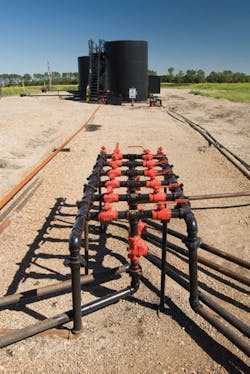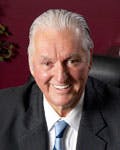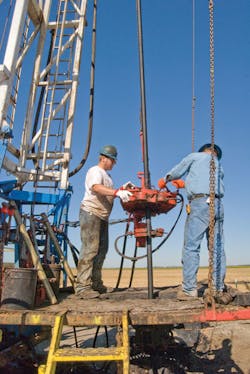AN INTERVIEW WITH TOM AND LAURIE CUNNINGTON: Privately-held Ward Williston leverages its E&P operation and oil service division
| EDITOR'S NOTE: Laurie and Tom Cunnington are president and CEO, respectively, of Ward Williston, a privately-held petroleum company and one of the oldest and largest producers in North Dakota. They recently took time to discuss the company and their plans with OGFJ. |
OIL & GAS FINANCIAL JOURNAL: Ward Williston is one of the oldest and most experienced operators in North Dakota. How did you first get involved in the Williston Basin and what changes have you seen? Also, tell us a little about your company's history and how it has evolved.
LAURIE CUNNINGTON: The Williston Basin is one of the most prolific oil basins in the United States. Recent advancements in technology have unlocked oil reserves in the basin – including the Bakken oil shale – that have the potential to significantly alter America's oil shortage. For more than 57 years, the Ward Williston Oil Company has successfully operated in the Williston Basin.
Ward Williston was started by a successful group of investors including Mr. Olds of Oldsmobile Corporation; Mr. Stroh of Stroh's Brewery; and other influential Detroit businessmen who financially backed the company's drilling programs in Michigan and North Dakota.
Ward Williston's founder was a wildcatter who drilled the second commercially successful oil well in North Dakota. Over time, most of the original investors passed away and the company was handed down to its heirs who did not share the same passion for the oil business as the founder. Production and reserves were in a steady decline until we acquired the firm in 1989. Tom and I saw an opportunity to build the company's underdeveloped reserves in an area where we knew there was oil.
TOM CUNNINGTON: Since 1989, we have worked aggressively to grow the company from 16 to 60 producing wells and today rank as one of the top 30 oil producers in North Dakota. Our progress and commitment to being a leading employer has been recognized by the many awards we have been fortunate to receive. We recently received the prestigious INC 500 Fastest Growing Privately Held Company in America award for the second time. Additional awards include the Patriotic Employer Award, Top Small Business in North Dakota Award, just to name a few. For two years running, the company has been nominated to Fortune Magazine's Best Companies to Work For, and Laurie has won the Ernst & Young Entrepreneur of the Year award and the Woman of the Month award, among others. All this has helped us establish a strong reputation in the marketplace.
OGFJ: What are some of WW's vital statistics (production rate, acreage, number of employees, proved reserves, etc.)?
LC: We produce about 600 boe per day, 100% of which is oil. We have 60,000 gross acres under lease and operate all 160 of our producing wells. We have grown proved reserves to about two million boe, and our probable and possible reserves are about 1.7 MMBOE. We employ 125 people, roughly split even between our E&P company and our oil service division. We have grown revenue, net income, and EBITDA at compound annual growth rates of 23%, 43%, and 33%, respectively.
OGFJ: Was WW an E&P company before getting into the oil service side of the business or vice versa? What kind of oil services does the company provide?
TC: While operations in the Williston Basin and in North Dakota are robust today, 57 years ago they were not. Inadequate infrastructure, lack of services, and limited personnel negatively impacted the ability to successfully produce and bring oil to market, so we made a strategic decision to launch our own oil services company, a division of Ward Williston, in 1958.
Our diverse portfolio of oil services provided us with the capacity to touch the well from drilling through completion, from its productive life to plugging, abandonment, and restoration. Our services arm provides oil and water hauling, vac trucks, hot oiling, service rigs, winch trucks, roustabout services, rental equipment (test tanks, mud tanks, heater treaters, pumping units, etc.), contract pumping, and consulting. This initiative and our focus on delivering high-quality services in a safe manner provided us with an additional revenue stream to make investments for growing our E&P division.
OGFJ: Most of the excitement coming out of North Dakota is related to wells being drilled horizontally in the Bakken oil shale. How has your approach to growth differed from that of the public companies focused on the Bakken, and has their success changed the way you look at things today?
LC: The Bakken play impacts us in two ways. First, many companies operating in the Bakken use Ward Williston as a primary service provider. Second, we believe that our leasehold is prospective for the Bakken/Three Forks. And the way the play is developing, it appears that the industry may be bringing it towards us. If this happens, we will need strong partners to help develop the potential resource under our leasehold.
Meantime, we will continue to grow based on the proven, but often bypassed Midale and other shallower pay zones. Although wells drilled in the Middle Mission Canyon intervals are smaller than horizontal Bakken wells, we can drill nearly 10 wells in the these prolific formations, mainly limestone, for the cost of drilling and completing one Bakken horizontal well. As a result, the Williston's shallower pay zones offer companies like ours an attractive risk-and-reward profile offering long-term growth opportunities. There is a lot of opportunity in the Williston Basin, we know because we've been operating there for 57 years. With our technology and our resources in place, we have been able to take advantage of new developments and opportunities.
OGFJ: As an E&P company and an oil service operator, how are you able to leverage your expertise on both sides of the industry to deliver superior results?
TC: We have the best of both worlds. On the service side, we work for most of the leading E&P companies operating in North Dakota, which gives us the opportunity to serve strong operators and learn their best practices and technologies. For example, we adopted rapidly the use of pump-off controllers when we saw our oil service customers use it, and then we enhanced it for our purposes. By immediately installing computers to monitor day-to-day operations and utilizing pump-off controllers, drilling operations can be monitored in real time back at the office. That is just one example of how our combined operations have helped us improve our operating efficiency and productivity, which is critical to being a successful operator in the Williston Basin.
On the E&P side, we developed an extraordinary system and methodology for mapping subsurface formations and combining that with critical surface data. We have information on every well in North Dakota in our database that incorporates formation tops, cultural items, wetlands locations, and other data that can be visually presented in one "mashed up" map. We know where the anomalies are and how to capitalize on them. That helps our E&P group know where to drill and exploit upside, which helps us provide knowledgeable advice and recommendations to our service customers.
Combining our staff's expertise from both the oil service and E&P divisions helps us leverage technology more effectively. Sharing information and bringing the perspective of both groups together has helped us develop new insight for controlling costs, producing more efficiently, high-grading internal prospects, and generating value for our oil service customers.
OGFJ: A growing number of private equity-backed companies have recently poured into North Dakota. How are you able to compete with these companies?
LC: The Bakken play has drawn a lot of attention, but the Williston Basin was a prolific oil province well before new technology unlocked the commercial viability of the Bakken. Several private equity-backed E&P companies have been quietly drilling up the Middle Mission Canyon intervals in the Williston and rapidly growing production and reserves, providing a strong foundation of cash flow and value for developing their Bakken potential. These private equity-backed companies will eventually need liquidity for their investors by way of a public offering or acquisition. The Williston Basin is considered mature, but there is still a lot of room to run in this area by applying new technology to the Middle Mission Canyon, the Bakken play, and capturing upside from secondary recovery projects. There's more in the Williston than any one company can handle on its own, and the fact that private equity-backed companies are coming back validates the basin as an asset that can provide many years of growth in several different ways. We see the new players not as a threat, but as potential E&P partners and customers.
OGFJ: As a private company, what has been your primary source of capital?
LC: We mainly use cash flow from operations and asset-based debt. When we want to develop our assets faster, we assemble and promote prospects to other oil and gas investors. In all cases, we seek to maintain a conservative balance sheet to ensure we can endure down cycles.
OGFJ: What do you see as the benefits of remaining a private company? Under what circumstances, if any, would you consider entering the public markets?
TC: In one sense, WW accesses the public markets by proxy, by partnering with public companies seeking to capture the long-term visible growth potential of our North Dakota acreage. Even though we aren't a public company, some of our partners are, which opens the flow of public funds into our company.
There are numerous benefits of being a private company. The main benefit is we can be nimble by picking and choosing projects that meet our long-term objectives as opposed to achieving an analyst's quarterly estimate. Even though we haven't made the leap to go public, we manage WW as if it were public by adhering to the stringent policies and procedures required by the SEC. Maintaining discipline and financial controls keeps us prepared should we decide to go public at some future date. In addition, being public adds a lot of overhead cost, which of course has to be covered by operations which in turn creates a higher break-even point. Maintaining low lifting and overhead costs gives us a competitive advantage. For example, public companies tend to offload their stripper production. Private companies, like ours, can do very well with stripper production due to lower overhead costs.
LC: We can also pursue attractive opportunities overlooked or under-emphasized by public companies. For example, we operate five waterflood projects that have been a source of strong production growth with competitive lifting costs. We plan to expand our existing waterflood pilot in our core Mouse River Park Field and initiate a new waterflood in our Little Deep Creek Field. The oil is already there, about 3.7 million barrels that can be recovered from those two fields with about $20 million in capital investment. That's a pretty good investment for any company, yet many public E&Ps shy away from waterfloods because they might not be the flavor-of-the-month desired by equity analysts. We will consider accessing the public markets when the opportunity from more rapidly developing our assets outweighs the costs and potential distractions of being public.
OGFJ: How do you allocate capital, resources, and people between your E&P division and your oil service business?
LC: We allocate our capital budget to the division that has the greatest return on capital after factoring-in maintenance and repair needs. It is a delicate balance. We see opportunities all the time and have to make strategic decisions that will deliver the highest value to the company in the long run. As commodity prices change, so does the relative attractiveness of drilling versus increasing revenue-generating capacity in the service business. Our service company investments are based on balancing fleet expansion and maintenance to ensure reliability, safety, and productivity
TC: E&P investments are always made when there is a positive internal rate of return. What changes is the form of investment. When we have many strong opportunities, we will raise drilling funds from partners. Otherwise, we prefer to fund our capital expenditures out of cash flow.
OGFJ: As a private company, there are numerous exit strategies. What is yours?
TC: Our plan is to continue growing the company to a critical mass that would make sense to make a public offering. This would provide funds to fully exploit our expertise in finding and producing oil. Also, we are always looking for other companies to acquire or merge with for achieving this goal more quickly.
OGFJ: What are some of the projects that Ward Williston is pursuing right now?
TC: At this time, we are focused on developing our capital budget for 2010 and even beyond. We have about 400 drilling locations on nearly 30,000 net acres to drill. We have drill-ready prospects ready to go, but the total opportunity provides us with many years of activity. Consequently, we are developing our strategic financial and operations plans and high-grading our prospect portfolio to make sure we rationally allocate capital to the best prospects first.
OGFJ: What kinds of returns are you looking at for these wells? Are they Bakken?
LC: The wells in our drilling inventory are relatively inexpensive and easy to drill. Drilling and completion costs are in the neighborhood of $750,000 to $800,000, at today's service prices. These are conventional wells, so completions are relatively low-tech, requiring only perforation and an acid job. With a good crew, we can drill these wells quickly with a spud-to-sales time of about 45 days. At a NYMEX price of $70 per barrel, we are realizing internal rates of return in excess of 100%.
TC: Obviously, these are not Bakken wells, but rather targeting shallower zones like the Midale, Wayne, and other Middle Mission Canyon intervals. Our acreage may have Bakken and Three Forks potential, but we aren't ready to say Ward Williston is a Bakken player yet.
OGFJ: We have heard about large negative price differentials in North Dakota because of the lack of take-away capacity out of the Bakken. What kind of pricing differentials are you experiencing?
TC: One of the advantages of having an oil service company to complement the E&P business is operational flexibility. We have heard of other operators experiencing differentials as much as $15 to $20 below WTI. Instead of competing for capacity on pipelines or rail cars, we are trucking most of our oil north into Canada, which tends to pay a higher price. As a result, our differential today is averaging $8.00 per barrel, much less than many operators, and that obviously improves our economics.
OGFJ: What are some of Ward Williston's competitive strengths?
LC: First, I realize that it is somewhat of a cliché to say that people are our strength, but they really are here at Ward Williston. Our operational success on both the E&P and oil service side has been the result of our people developing new ideas, giving them the room to take appropriate risks, and then learning from both our successes and failures. That process builds expertise and has helped us develop new ideas for reducing costs and finding new opportunities.
TC: I agree. And because of that process, we have implemented new technologies in ways that our customers and partners notice. For example, we were one of the first companies in the basin to install computer-based, well-monitoring equipment and pump-off controllers on our wells, which helps us do more with fewer resources. Our oil service company was an early adopter of GPS technology for optimizing routes and increasing our responsiveness to customer needs – if a customer calls and needs a load of water hauled, we can identify the closest unit and route it to the location for the fastest response time. Those ideas and more came at the suggestion of our team.
In addition, because Ward Williston has been operating in the Williston Basin for more than 50 years, most of our leasehold is held by production. That gives us a large platform for developing not only our current prospects, but also for realizing the potential that may develop in the future.
OGFJ: What is the next major challenge facing Ward Williston?
LC: I believe it will be managing our growth effectively. We have done a good job growing from just a small team to 125 employees in two divisions. Our plans to increase drilling activity, get our waterflood projects up and running, and building our service capacity to meet customer demand will challenge us in a good way. We know we will need to put into place the right people and systems for reaching the next level of growth without sacrificing service quality, safety, or efficiency. That is something we think about every day.
OGFJ: Final question: What major lessons have you learned since buying Ward Williston in 1989?
TC: No matter how you look at it, the oil and gas business is a cyclical one. Maintaining a strong cost discipline and striving to be a low-cost producer never goes out of style. It also helps to have a great asset base and we are fortunate to be situated in one of the most prolific and productive oil producing areas in the country. Over time, we may find that the Williston Basin is one of the best oil provinces in the world.
OGFJ: Laurie and Tom, thanks so much for taking the time to talk with us and share your story with our readers.
More Oil & Gas Financial Journal Current Issue Articles
More Oil & Gas Financial Journal Archives Issue Articles
View Oil and Gas Articles on PennEnergy.com





